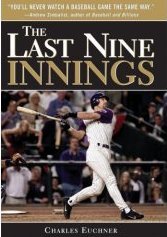 In The Last Nine Innings (Sourcebooks), Charles Euchner examines several aspects of the modern revolution in baseball.
In The Last Nine Innings (Sourcebooks), Charles Euchner examines several aspects of the modern revolution in baseball.Using Game 7 of the Yankees-Diamondbacks 2001 World Series as a backdrop, Euchner explores: (a) how the use of psychology, modern science and computer imaging at places like the American Sports Medicine Institute helps break down hitting and pitching mechanics to uncover better ways to train (and in turn teaches us how the body, including the brain's rostromedial prefrontal cortex, operates during a game), (b) the ever-growing influence and use of statistical analysis, and (c) the globalization of the game, and its affects on business, scouting and on-field strategies.
I am most fascinated by the thousands of in-game questions and how new ways of analyzing the game has changed, and continues to change, both the questions and the answers, and how fans connect to the game on the field.
The first key moment in the game came in the bottom of the sixth inning. There is no score and Steve Finley has just singled off Roger Clemens. Danny Bautista is walking to the plate. Euchner then spends the next 13 pages discussing possible strategies (for both teams) and how the Bautista at-bat developed.
First, should Bautista bunt? Euchner shows that during the entire 2001 season, teams scored fewer runs with a man on second and one out (.7026) than with a man on first and no outs (.9227) -- meaning that the act of successfully bunting the runner to second in that situation actually hurt a team's chance to score. (It is no small point to understand that this runs counter to what most people in the game believe.) And those numbers shouldn't be taken as an iron-clad rule against bunting, but they do show that teams should carefully chose their spots for a sacrifice.
So will Bautista bunt? Will he swing away? Maybe Finley will try to steal, or just take a long lead to distract Clemens? Would a throw over to first base (or a waste pitch for ball 1) cause Finley or Bautista to briefly reveal what they are planning to do? Each of Arizona's possible decisions will affect which pitches Clemens decides to throw, and where to throw them, which will in turn affect how the Yankees decide to position their fielders, which could affect Finley's decisions on the basepaths, and so on. And some or all of these decisions may change as Bautista's at-bat continues.
Also, Clemens had thrown 92 pitches at that point -- and as soon as Finley singled, Ramiro Mendoza began warming up in the New York bullpen. There was no DH in this game, but Clemens had made the last out in the top of the sixth, so his spot in the lineup would not be up for approximately two innings, removing one topic of consideration from Joe Torre's mind.
Euchner does an excellent job of weaving in quotes from many of the players, as well as Diamondbacks manager Bob Brenley, as he discusses Bautista's batting average against certain pitches in certain areas of the strike zone and how a runner dancing off first base might help or hinder a batter's performance. It's tough to pull off these digressions -- while often following the game pitch-by-pitch -- without losing causal readers in a maze of strategy and yet Euchner gets deep enough to also engage those fans who understand OPS+ and linear weights. I would have liked Euchner to get into all of his topics a bit more, but he may have lost that important balance in the process.
I actually grew a little nervous about the outcome as I was reading (and following along on my scorecard from November 4, 2001) about the last two innings. Sports Illustrated's Tom Verducci, in one of the book's blurbs, says Euchner "educat[es] the serious fan while entertaining the serious one". The reverse is also true. The Last Nine Innings will entertain the serious fan while educating the causal one.
Euchner shows that during the entire 2001 season, teams scored fewer runs with a man on second and one out (.7026) than with a man on first and no outs (.9227) -- meaning that the act of successfully bunting the runner to second in that situation actually hurt a team's chance to score. (It is no small point to understand that this runs counter to what most people in the game believe.)
ReplyDeleteAverage # of runs != chance of scoring one run. Sacrificing no doubt kills the chances of having a big inning, but if the team at bat has decided that it just wants one run (usually later in the game), does sacrificing improve the chances of getting one run in, especially against a top pitcher? This is what people argue about.